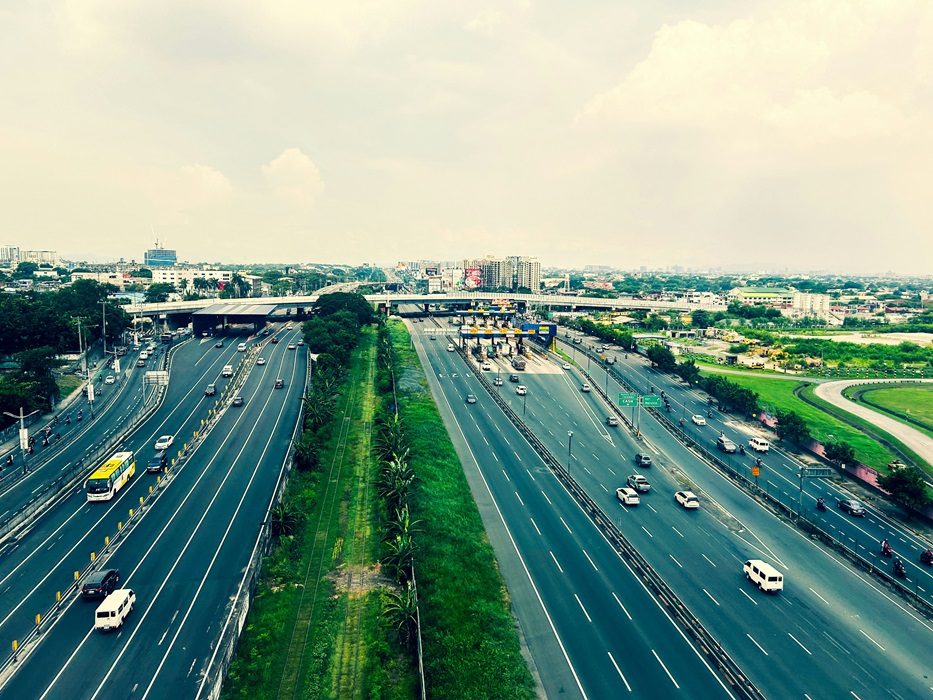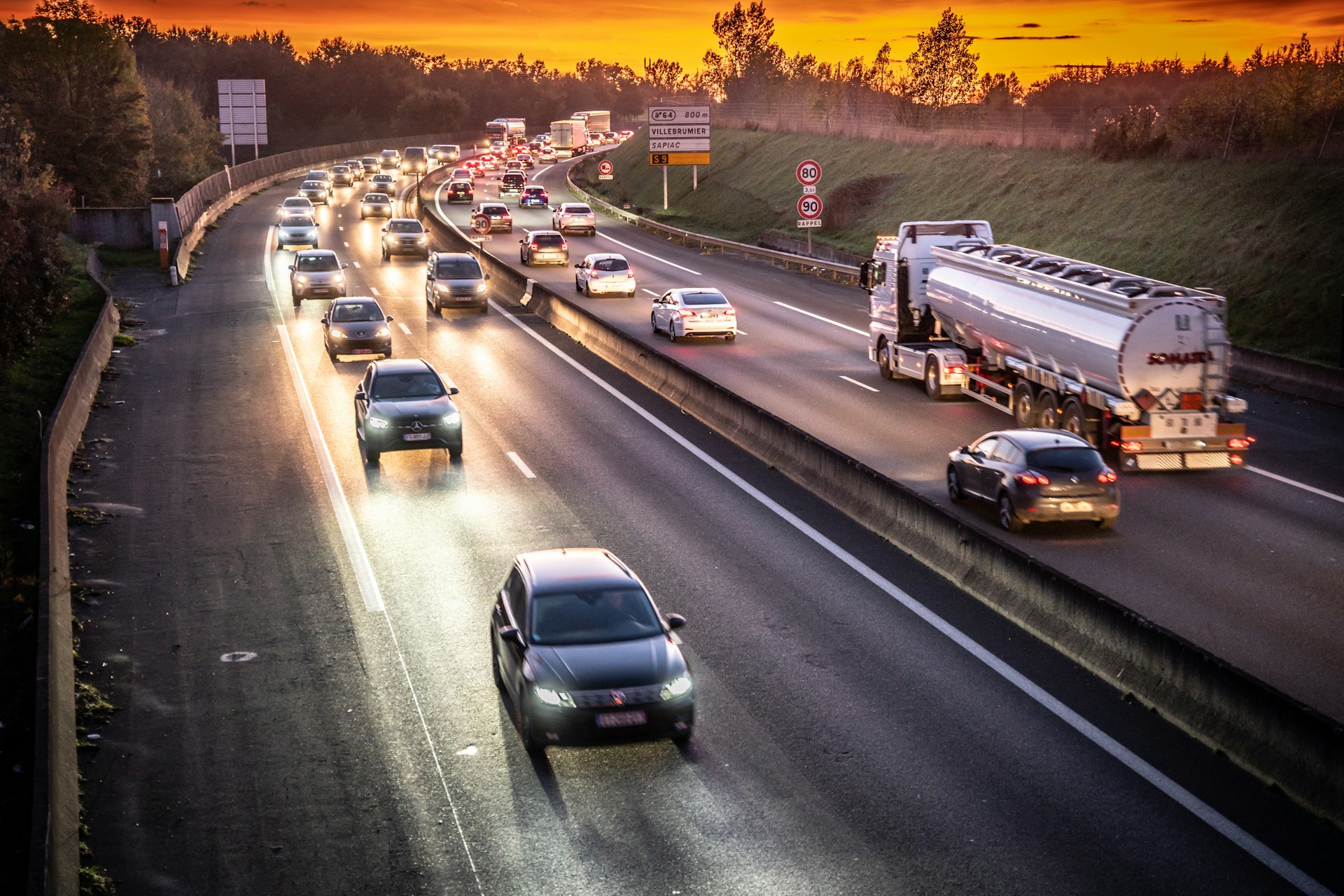This article is also available in 🇫🇷 French, 🇩🇪 German and 🇪🇸 Spanish.
Since 2019, free-flow tolling has gained popularity in France: already six French motorways are adopting this system. With this technology, motorists can drive without stopping at traditional toll barriers. Let’s explore how open-road tolling works and what drivers should expect when visiting France by car or motorbike.
Free-flow tolling, also called open road tolling, all-electronic tolling, or cashless tolling, allows vehicles to pass under gantries without slowing down or stopping. It’s an alternative to traditional toll barriers with booths. These gantries are equipped with cameras and sensors to record license plate numbers and detect toll badges.
Drivers can pay for their journey using various payment methods:
- Online, before or after each trip
- Via a subscription service
- With an electronic toll badge
- In cash (in some cases)
This free-flow model stands out for its efficiency and ability to ease traffic flow.

Free-Flow Toll in France:
- French Motorways with Open-Road Tolling
- How to Pay a Free-Flow Toll in France?
- Advantages of Open-Road Tolling
- What to Do if I Forgot to Pay or I Received a Reminder?
- Additional Resources
- FAQ Open-Road Tolling in France
1. French Motorways with Open-Road Tolling: A4, A10, A13, A14, A79, and A837
Several motorway sections are operating with free-flow tolling, including:
- A79 motorway: One of the first major roads in France to adopt barrier-free tolls. The section connecting Montmarault to Digoin is a prime example.
- A4, A10, and A837 motorways: Some sections, particularly in Île-de-France, use free-flow gantries to ease congestion in heavily trafficked areas.
- A13 and A14 motorways: Heavily used by motorists traveling from Normandy to Paris, these motorways benefit from free-flow technology to improve traffic flow at the capital’s entrance.
These roads are managed by different operators (Vinci Autoroutes, SANEF, and Aliae), marking a new era for motorway infrastructure in France.
2. How to Pay a Free-Flow Toll in France?
When driving on a motorway with free-flow tolling, you can pay either before or after your trip. Payment methods may vary slightly between operators, as outlined in the table below:
| Highway | Operator | Pay for a trip online | Cash payment | Account creation |
| A4 – A13 – A14 | SANEF | SANEF Website | Authorized tobacco shops (Nirio, map here) | SANEF Account |
| A79 | Alie | Alie Website | Via payment terminals on A79 or Nirio | Sesame Fulli Account |
| A10 – A837 | Vinci | Ulys Free account (required) | No | Ulys Free Account |
Before the Journey on an Open-Road Tolling Motorway
Frequent users of French free-flow motorways have several options to prepare their trip and ensure payment is handled:
- Toll payment subscription: With a toll payment badge or a customer account, the amount is automatically deducted when your vehicle passes under the gantry. This is the simplest and most convenient solution, especially for frequent travelers.
- Advance payment: Platforms like Ulys and Aliae allow drivers to prepay by entering their license plate.
- Mobile applications: Apps like Fulli make it easy to pay and track journeys.
After the Free-Flow Motorway Journey
If you haven’t paid in advance, don’t worry! You can settle the toll within three days of passing through the gantries:
- Online payment: Pay via the operator’s website, e.g., paiement.aliae.com, by entering your license plate.
- Physical terminals or FDJ points: You can pay at Nirio-approved FDJ points or via nearby terminals.
Make sure to pay promptly to avoid penalties. In France, you have 72 hours to settle a free-flow toll.

3. Advantages of Open-Road Tolling
The French government has promoted the adoption of this technology. Discussions began in 2018, leading to the 2019 mobility orientation law, which recommended the use of free-flow tolling.
The first tests occurred in early 2019 on the A4 motorway, replacing the Boulay Moselle toll with a free-flow system. While there may be some issues, the system is largely beneficial. Here’s why:
Ecology and Traffic Flow
One of the main advantages of free-flow tolling is its positive impact on the environment. By eliminating the need to stop at toll barriers, CO₂ emissions are reduced. Traffic jams around traditional tolls are also avoided. Such an approach facilitates the flow of traffic. Which makes motorway journeys much less stressful for travelers.
Time-Saving and Comfort
The absence of barriers and slowdowns saves considerable time. Particularly on the busiest roads and during the summer rush hour. By making traffic flow more fluid, drivers can cover distances more quickly, without having to stop.
Free-flow tolls are also part of a logic of increased comfort for motorists. By eliminating the need to look for something to pay or to queue at toll booths, road trips in France become more pleasant.
Safety
Speed differences between vehicles is a factor that increases the risk of accidents. With the old system, even holding a badge required cars to reduce their speed by up to 20 mph. Approaches to barriers are often areas where the risk of accidents is high.
Their removal therefore eliminates this safety risk. In addition, the reduction in fatigue and stress while driving should also have positive consequences on the accident rate in France. More rested and calmer drivers are more alert.
4. What to Do if I Forgot to Pay or I Received a Reminder?
If you forgot to pay for a free-flow section, you have 72 hours to pay without penalty. Simply:
- Go to the motorway operator’s dedicated website (e.g., Ulys or Aliae).
- Enter your registration plate number.
- Follow the payment instructions.
If you fail to pay within 72 hours, a reminder will be sent. If you settle within 15 days, a penalty of €10 is applied, in addition to the toll fee. After 15 days, the penalty increases to €90. If not paid within two months, the penalty jumps to €375. It’s best to resolve these notices quickly to avoid further complications!
5. Additional Resources
Free-flow tolling marks a major improvement for France’s motorway network. It offers smoother, more comfy journeys while reducing emissions. However, drivers must familiarize themselves with the payment methods. The easiest way is to create an account or use a toll payment badge for automated payments.
To learn more about free-flow tolling, visit:
6. FAQ
How is my registration plate recorded?
Gantries are equipped with high-definition cameras that record your plate when you pass at normal speed. If you’ve linked a payment method to your plate, you’ll be automatically charged.
What’s the difference between an electronic toll badge and an account?
An electronic toll badge works with all French operators and abroad (Spain, Portugal, Italy). An account is operator-specific. Frequent travelers may prefer a badge, while those who mainly use the same motorway can stick to an account.
Can I still pay in cash?
Yes, except for Vinci-operated roads. You can pay within 72 hours at Nirio-approved FDJ points of sale. For the A79, you can also pay in cash at nearby terminals.
Are there penalties if I forget to pay?
Yes, late payments incur a penalty of €10 if paid within 15 days of the reminder. After that, it increases to €90, and after two months, it rises to €375.
How can I tell if a motorway uses free flow?
Free-flow sections are clearly indicated by signs ahead of time. You can also check the motorway operators’ websites.